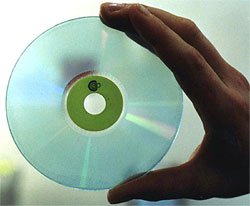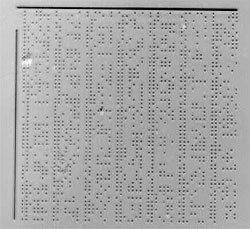Fluorescent Multi-Layer Memory
Bigger, Better Memory with Constellation 3Ds.
Fluorescent Multilayer Disks
 How do you boost a computer's memory, both in capacity and in speed? The usual
model for memory storage features a recording/reading device (a "read-write
head," a "probe tip," a "stylus,") and a surface on which that device
can make its impression. So it's not surprising that some of the most
promising research in the memory industry features a simple modification of that
paradigm. Instead of just one recording surface, researchers are now thinking of
using up to 100 layers, and a corresponding number of recording/reading devices,
to store ever-greater quantities of data.
How do you boost a computer's memory, both in capacity and in speed? The usual
model for memory storage features a recording/reading device (a "read-write
head," a "probe tip," a "stylus,") and a surface on which that device
can make its impression. So it's not surprising that some of the most
promising research in the memory industry features a simple modification of that
paradigm. Instead of just one recording surface, researchers are now thinking of
using up to 100 layers, and a corresponding number of recording/reading devices,
to store ever-greater quantities of data.
This technology is already being used in DVD players, which use two
simultaneous layers for memory storage. When researchers at IBM tried increasing
the number of layers, however, their multiple laser beams encountered so much
interference that the company decided to forego further explorations in this
field. The laser beams required to read each layer were corrupted upon passing
through other layers. It might have been a dead end for multilayer systems, had
fluorescent coatings not stepped in to save the day.
When multiple layers of storage material are coated with fluorescent
material, they turn intervening laser beams into fluorescent light. This
fluorescent light is immune to corruption from intervening layers and other
lasers. More specifically, each base layer is marked with a pattern of "pits."
When this layer is coated with fluorescent material, the pits gather a greater
thickness of fluorescent stuff. The contrast between pit-thickness and
layer-thickness of fluorescent material results in a unique reading of stored
data.
This fluorescent material is currently made of polymers that are owned by
Constellation 3D. The company intends to market these polymers to other firms,
as well as produce the 3D data-storage systems themselves. It looks to be a huge
score for the firm. In a field where increasing storage capacities mean greater
danger of data corruption, Constellation 3D has found a back door to long-term,
high-capacity memory. Research has shown that systems using fluorescent material
resist corruption much longer than naked systems. And researchers have recently
posited devices containing as many as 100 layers separated by fluorescent
coatings -- shattering earlier forecasts of feasible storage capacities.

Not only will storage capacities be exponentially increased; the technology
is also potentially much faster at accessing information than are single-layer
devices. Multiple layers can be read simultaneously, as can different patches of
the same layer. This is an important step towards commercializing the product
because, up to this point, technologies have tended to focus on either capacity
or speed, failing to incorporate both.
Ease of upgrading is another strategic advantage to multilayer fluorescent
technology. Existing CD and DVD manufacturing lines can be modified to FMD
standards without altering their essential structure. Most systems would only
require a few extra steps to deposit coatings with fluorescent materials.
As to the fluorescent material itself, there are a few criteria that need to be
met. Most generally, the fluorescent material must be compatible with the layer
it's coating, and the wavelength it absorbs must be identical to that used
in the drive. It must be a reasonably stable material, although its response
time should not be greater than 1 nanosecond. With its refraction index similar
to that of its polycarbonate sublayer, the fluorescent material must have a high
conversion efficiency. Finally, the beam that gets reflected through the
fluorescent material should be wavelength-shifted by at least 50nm so that the
two beams do not get confused within the system.

